#catherine : cluster diamond wedding gift ring
Text
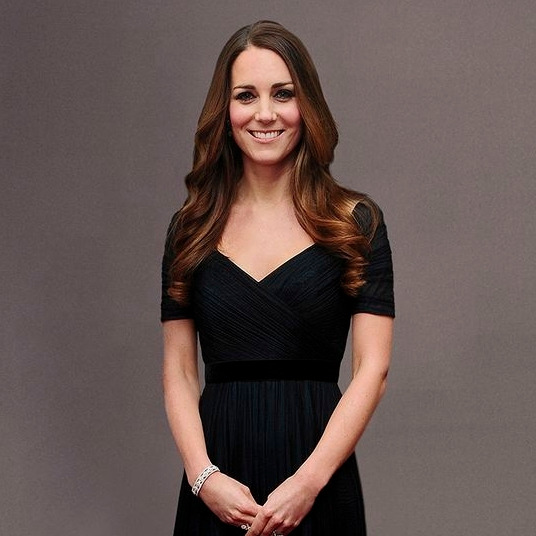

CATHERINE'S STYLE FILES - 2013
24 OCTOBER 2013 || The Duchess of Cambridge attended the 100 Women in Hedge Funds annual gala dinner in aid of Action on Addiction in London.
#catherines style files#style files 2013#mine.#24.10.2013#100 women in hedge funds#100 women in hedge funds gala 13#jenny packham.#catherine : cluster diamond wedding gift bracelet#catherine : diamond wedding gift bracelet.#catherine : cluster diamond wedding gift earrings#catherine : cluster diamond wedding gift earrings.#catherine : cluster diamond wedding gift ring.#catherine : cluster diamond wedding gift ring#catherine : cluster diamond wedding gift suite.#catherine : cluster diamond wedding gift suite#british royal family#british royals#brf#british royalty#royalty#royals#royal#kate middleton#catherine middleton#duchess of cambridge#princess of wales#the princess of wales#princess catherine
50 notes
·
View notes
Text

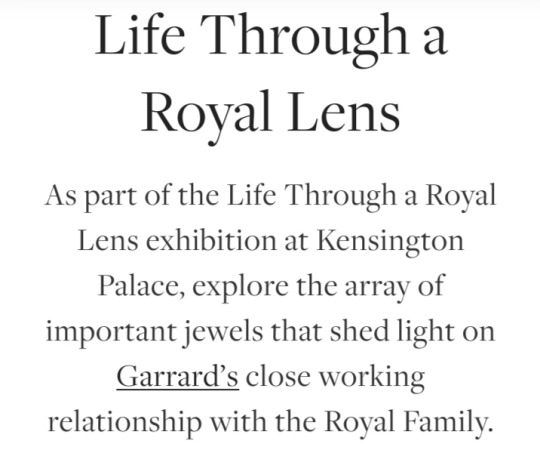
In her “accession” photographs, shot in 1952 by Dorothy Wilding, HM Queen Elizabeth II is pictured with the Girls of Great Britain and Ireland Tiara upon her head – a jewel that you might recognize because Her Majesty is seen wearing it on the front of every Bank of England banknote.
Originally the property of Queen Mary, Duchess of York, Princess of Wales and finally Queen Consort of King George V, the Girls of Great Britain and Ireland Tiara was crafted by Garrard in 1893 to be given as a wedding present from the Girls of Great Britain and Ireland committee.
Designed to be transformable, allowing it to be worn as either a necklace or coronet, over the years, Queen Mary requested that Garrard add diamonds, remove pearls, and separate the bandeau from the base so that she could wear it as a headband.
In 1947, Queen Mary gave the tiara to Princess Elizabeth as a wedding present. In 1969, now Queen Elizabeth II, she asked for the bandeau and tiara to be reunited, as it remains today.
Worn frequently by Her Late Majesty The Queen, the Girls of Great Britain and Ireland Tiara is an ongoing source of inspiration for Garrard’s designers, with the repeated pattern of diamonds encircling the base reflected in the round and geometric Windsor motif, which is a signature of the Albemarle and Fanfare jewellery collections.

The Queen’s love of brooches is legendary, and in Bob Thomas’ intimate portrait of Her Majesty at the Royal Windsor Horse Show, she is pictured wearing the Cullinan V Heart Brooch, one of several important brooches commissioned from Garrard by the Royal Family.
Showcasing the 18.80-carat heart shape Cullinan V diamond, the fifth-largest gem to be cut from the 3,106-carat Cullinan Diamond – the largest gem-quality rough diamond ever discovered – the diamond was given to Queen Mary in 1911 as a gift from the South African government.
It was originally worn by Queen Mary as part of the suite of jewellery made by Garrard for her to wear at the Delhi Durbar in 1911.
When Queen Mary died in 1953, the Cullinan V Brooch was passed to her granddaughter, Her Late Majesty Queen Elizabeth II, who was photographed wearing it throughout her reign.

The Sapphire and Diamond cluster ring worn by Catherine, Princess of Wales, formerly Duchess of Cambridge, in the 2013 portrait by her father Michael Middleton is among Garrard’s best-known creations.
Set with a magnificent 12-carat oval Ceylon sapphire, encircled by a cluster of diamonds set in 18 carat white gold, the ring was personally chosen by Lady Diana Spencer for her engagement to Prince Charles.
It became instantly famous after it was prominently showcased in an engagement shoot in 1981 that took place in the grounds of Buckingham Palace.
A new chapter in the story of Princess Diana’s engagement ring was written when, in 2010, William, Prince of Wales, formerly Duke of Cambridge, chose to propose to Catherine Middleton with the same engagement ring his father had given to Diana.
As this royal jewel, passed down through generations, takes on new meaning and sentiment upon Princess of Wales’ hand, we continue to honour this history-defining design in the 1735 collection.
Garrard’s iconic cluster setting also features prominently in the Jewelled Vault, where each one-of-a-kind creation is designed around an exceptional central stone.

A page from the scrapbook of Princess Victoria of Wales, daughter of King Edward VII and Queen Alexandra, shows photographs of Alexandra, dating from 1901, wearing a diamond crown that is much smaller than a traditional royal crown.
Crafted by Garrard in 1871 at the request of Queen Victoria, the miniature crown was designed to be worn over Queen Victoria widow’s cap.
Set with more than 1,000 diamonds and featuring alternating crosses and fleur-de-lis motifs, Garrard created the crown so that the arches could be removed.
Queen Victoria wore the Small Diamond Crown for the first time at the opening of Parliament in 1871 and frequently thereafter for state occasions.
After Queen Victoria’s death, the crown was worn by Queen Alexandra, who in turn passed it to her daughter-in-law, Queen Mary.
Today, Queen Victoria’s Small Diamond Crown is housed at the Jewel House at the Tower of London, where it is on display.
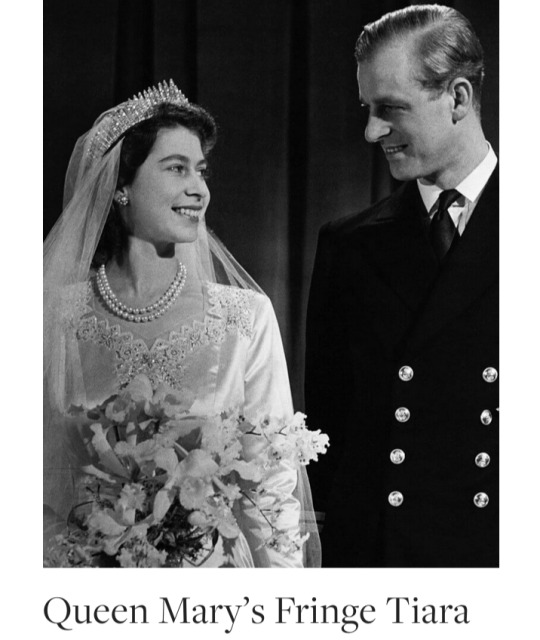
Both King George VI and HM The Queen are pictured wearing the Imperial State Crown in the Life Through a Royal Lens exhibition.
The 10th iteration of this historic jewel, the crown was crafted by Garrard in 1937 for King George VI and adjusted for The Queen ahead of her coronation in 1953.
Some of the most historic gems in the royal collection reside in this Crown Jewel, including, at the front of the crown, the Cullinan II, the second largest diamond cut from the 3,106-carat Cullinan Diamond – the largest gem-quality rough diamond ever discovered.
Above it, mounted on a diamond Maltese cross, is the Black Prince Ruby, which is not a ruby at all.
In the 16th century, it was discovered that this blood-red semi-polished stone is, in fact, a spinel, a gem that is often referred to as “the great imposter” after it was discovered that some of the most famous “rubies” seen in crown jewels around the world are, indeed, spinels.

A big moment in Garrard’s history was the recutting of the Koh-i-Noor Diamond.
This sizeable white diamond was first displayed to the public at the Great Exhibition of 1851.
In 1852, Prince Albert, who was instrumental in the creation of the Exhibition, commission Garrard to recut the diamond.
The intensely demanding cutting process lasted eight weeks and was overseen by The Duke of Wellington.
Garrard worked to create more facets to enhance its beauty; consequently, the diamond emerged as a dazzling brilliant weighing 105.6 carats.
In 1911, the Koh-i-Noor was set into Queen Mary’s Crown, newly created by Garrard for the Coronation.
Today, the fabled Koh-i-Noor Diamond (which is now only worn by a woman – if a man wears it, he will supposedly be cursed) is set at the centre of The Queen Mother’s Crown created by Garrard in 1937.

In a black-and-white photograph taken at the Delhi Durbar in 1911, held to mark the coronation of King George V and Queen Mary as Emperor and Empress of India, Queen Mary is pictured wearing the magnificent Delhi Durbar Suite.
Created by Garrard at the request of the Queen, who wanted a suite of jewels that perfectly captured the majesty of the occasion, the suite included an emerald and diamond tiara, earrings, a brooch, a stomacher, and a spectacular necklace.
Designed by Garrard in a striking circlet style, the Delhi Durbar necklace is set with eight large cabochon emeralds known collectively as the Cambridge Emeralds, with a pendant suspended beneath set with a ninth Cambridge Emerald.
In 1912, Garrard made slight alterations to the necklace, making the emerald pendant detachable and adding a second removable pendant showcasing the 8.80-carat marquise cut Cullinan VII diamond.
Queen Mary regularly wore the necklace and the other jewels in the parure for the rest of her life, after which they became the property of Her Late Majesty Queen Elizabeth II, who inherited the Delhi Durbar Necklace in 1953 and had worn it on many occasions.
The Delhi Durbar Tiara, meanwhile, was given by Her Late Majesty The Queen to Camilla, Queen Consort, after her marriage to His Majesty King Charles III.

Commissioned by Queen Mary in 1919, the Fringe Tiara was crafted by Garrard in the fashionable Russian style reminiscent of a kokoshnik and designed to be convertible so that it could be worn as either a tiara or a necklace.
Queen Mary gave the tiara to her daughter-in-law, Queen Elizabeth, later the Queen Mother, who was pictured wearing it in Cecil Beaton’s whimsical portrait.
Queen Elizabeth in turn loaned it to her daughter, Her Late Majesty Queen Elizabeth II, then Princess Elizabeth, to wear for her wedding to Philip Mountbatten in 1947 as her “something borrowed.”
In 1974, the Queen Mother loaned the Fringe tiara for another royal wedding, that of her granddaughter Princess Anne.
Most recently, it was worn by Princess Beatrice on the occasion of her wedding to Edoardo Mapelli Mozzi in 2020.

Originally created by Garrard in 1870 for Florence, Lady Poltimore, the 2nd Baron of Poltimore, the Poltimore Tiara was not publicly known until it was acquired by Princess Margaret prior to her engagement to Antony Armstrong-Jones in 1959.
Featuring elegant diamond scrolls evocative of flora – an enduring source of inspiration during the Victorian era in which it was made – it quickly became one of the Princess’s most prized possessions.
In the ensuing years, both Margaret and the towering jewel were regularly in the spotlight, including, most famously, the photograph on show as part of the Life Through a Royal Lens exhibition featuring the Princess wearing the Poltimore Tiara in the bathtub.
#Queen Elizabeth II#HM Queen Elizabeth II#Girls of Great Britain and Ireland Tiara#King George V#Queen Mary#Cullinan V Heart Brooch#Sapphire and Diamond Cluster Engagement Ring#Lady Diana Spencer#Diana Princess of Wales#Catherine Middleton#Catherine Princess of Wales#Queen Victoria#Prince Albert#Small Diamond Crown#Queen Alexandra#Imperial State Crown#Cullinan II#Black Prince Ruby#Koh-i-Noor Diamond#Great Exhibition of 1851#Delhi Durbar Suite#Cambridge Emeralds#Cullinan VII#Delhi Durbar Tiara#Fringe Tiara#Poltimore Tiara#Princess Margaret#British Royal Family#Dorothy Wilding#Tower of London
53 notes
·
View notes
Text
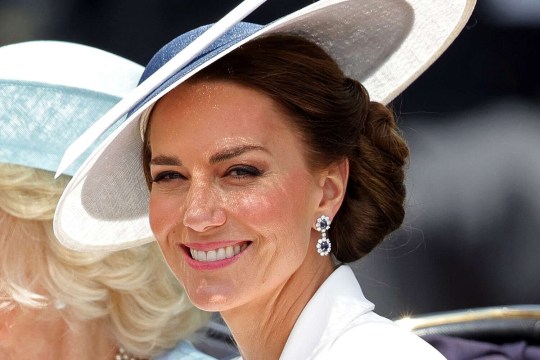
Kate Middleton at Trooping the Colour 2022
This is the first time we've seen Kate wear this pair of earrings in public," Lauren Kiehna, writer of The Court Jeweller blog, tells PEOPLE, explaining why it was such a significant reveal.
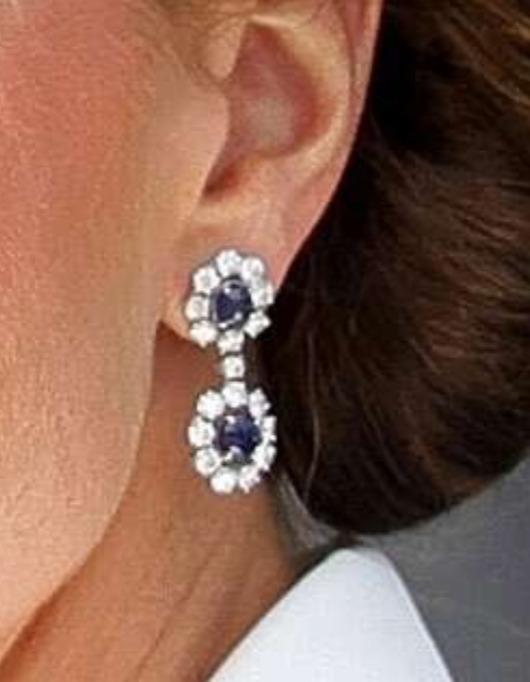
For the last ten years, Kate has worn a smaller pair of sapphire and diamond earrings that there widely believed to have been fashioned using the very same pair that Kate wore for Thursday's parade. Because the original pair had not been seen since Diana's death, the rumor continued to circulate, although Kiehna was always adamant that the earrings were two separate pairs.
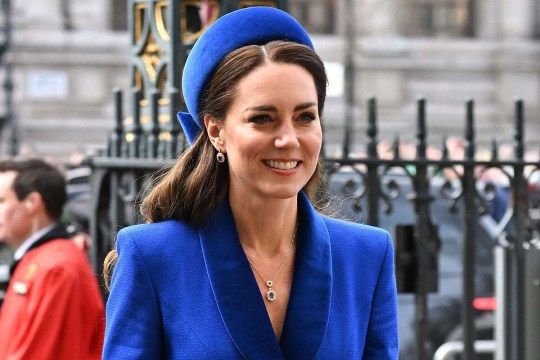
Kate Middleton at the Commonwealth day Service in 2022 Karwai Tang/WireImage
Diana had several sapphires in her jewelry collection. She wore these particular earrings on several occasions including to the Met Gala in New York in 1996 and also during a visit to Canada in 1991, both times paired with a sapphire and pearl choker.
The giant sapphire was originally a brooch, gifted to Diana by the Queen Mother as a wedding present. It later became the central piece of the seven-stranded pearl necklace that became a favorite of Diana's — another piece that Kate may well have inherited but has not yet been seen.
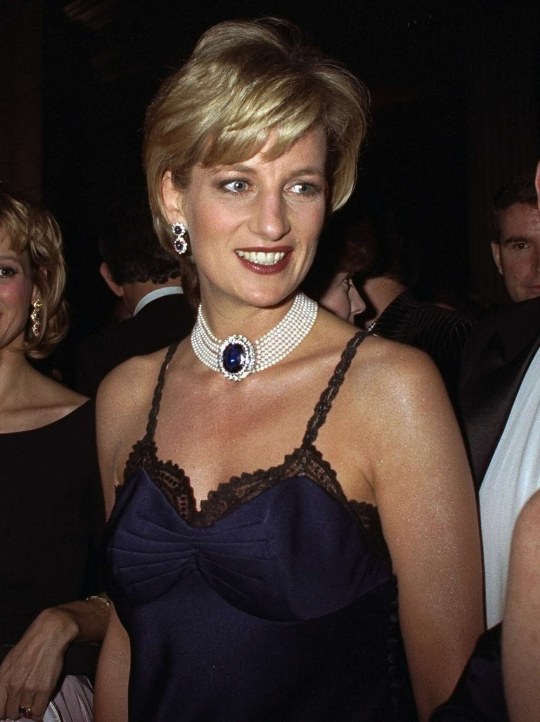
Princess Diana at the Met Gala in 1996
While it's not clear why Kate waited until now to wear the earrings publicly, she clearly has her favorites and the smaller ones may just be easier to wear. As Trooping the Colour is so synonymous with marking history and the line of succession, it may well be that Kate thought it was the perfect time for their debut. Prince Louis' outfit also took a nostalgic turn wearing a sailor suit that his father Prince William had worn at the same event 37 years ago.

Catherine Duchess of Cambridge and Prince William with Prince Louis, Princess Charlotte and Prince George at Trooping the Colour 2022

Catherine Duchess of Cambridge meeting the President of Ukraine
One sapphire piece of jewelry that Kate never takes off is her famous sapphire and diamond cluster engagement ring, which also belonged to her late mother-in-law. William proposed to Kate with it in 2010. The ring's central faceted oval Ceylon sapphire is estimated to be 12 carats and is surrounded by 14 round diamonds.
#princess diana#catherine duchess of cambridge#diana's sapphire jewelry#kate's jewelry#platinum jubilee#princess Diana
22 notes
·
View notes